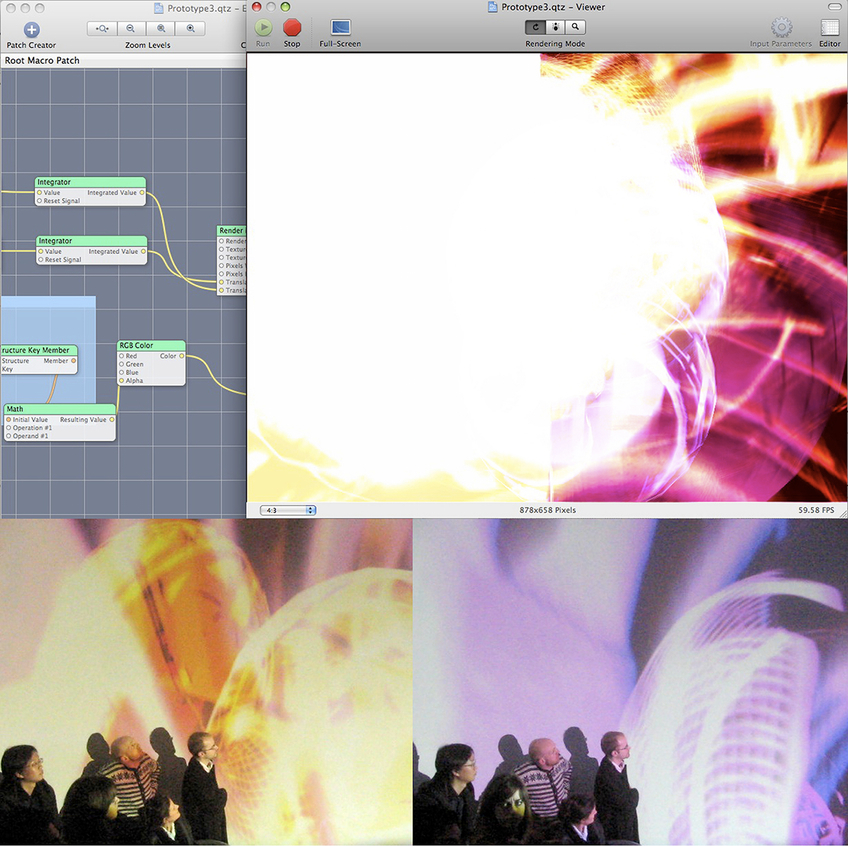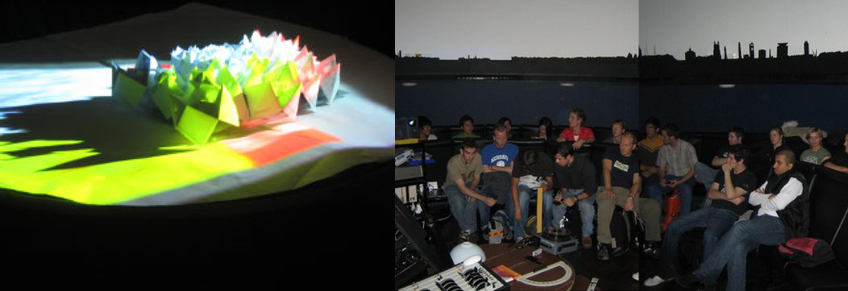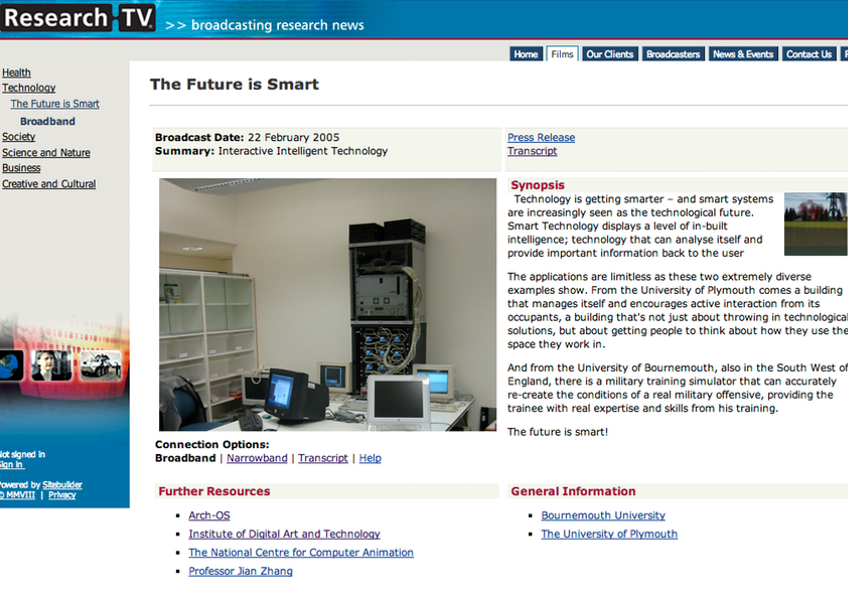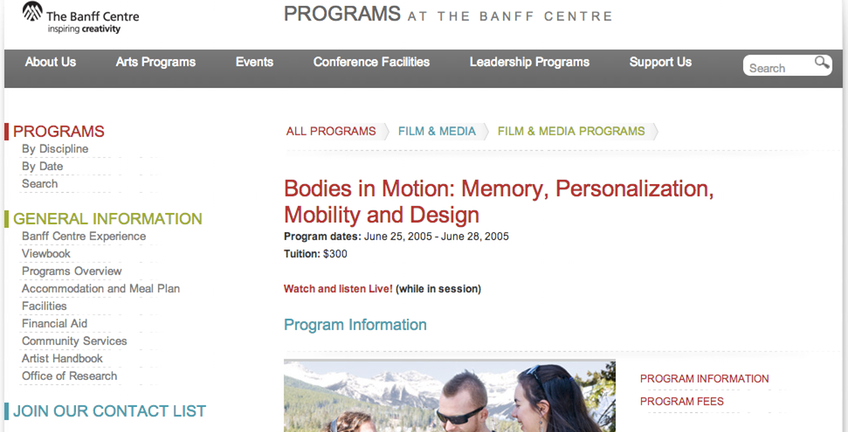Arch-OS Workshops
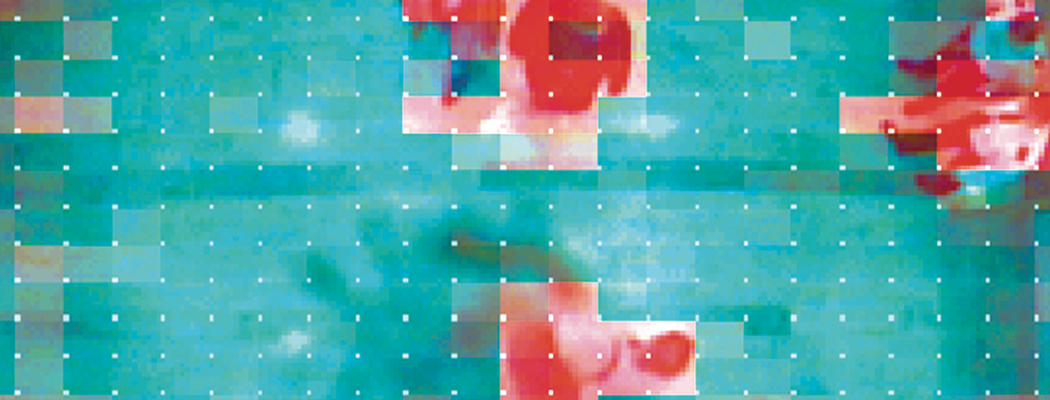
AHO+BARTLETT= i-DAT:
A trans-disciplinary research workshop on Arch-OS
25th – 27th February 2009
A trans-disciplinary research workshop on Arch-OS: Architectural ecologies: from aesthetics to behaviour, an interdisciplinary approach to affecting the relationships and interactions between inhabitants and their architectural environment. With:
Advanced Architectural Design, AHO Oslo School of Architecture and Design, Norway: http://www.aho.no/en/
&
A.V.A.T.A.R, Bartlett School of Architecture, University College London, UK:http://www.avatarlondon.org/
Workshop details: AHO+BARTLETT=i-DAT.pdf
This workshop will experiment with and forecast potential future use, impact and value of using ‘data’ generated by a building and its inhabitants, to recursively influence behaviour, creating a symbiotic ecology with a potential greater environmental awareness. Through an interdisciplinary approach it will encourage the development of an organic list of solutions or potential methodologies for building design based on the study of the main factors: behaviour, data and interaction. The resultant hybrid construct has the potential to expand and evolve our physical and conceptual space, and behaviours and interaction within these.
———————————————————————————————————————-
PROCESSING WORKSHOP/GREENSCREEN
(05/11/2007). Ruairi Glynn b-DAT graduate and developer of interactive architectures (see interactivearchitecture.org) delivered a 3 day Processing workshop in processing. A-Tec researchers and students worked with Arch-OS data feeds to develop dynamic imagery for the Green Screen installation in Portland Square.
Part 1: http://www.youtube.com/watch?v=W388aBDmo2o
Part 2: http://www.youtube.com/watch?v=viY8dGx_mAI
———————————————————————————————————————-
Unit 20-Bartlett School of Architecture
Unit 20-Bartlett School of Architecture, UCL. + Arch-OS
Arch-OS workshop for Unit 20 Postgraduate students. 12-13/10/05:
MIMETIC+NUCLEI+BOUNDARIE+FIELDS+TERRITORIES
Mimesis: implies identity and representation
Nucleus: implies density and growth
Boundary: implies limits and greatest possible degree
Field: implies events and rules
Territory: implies occupation and interaction.
The workshop was run around the Arch-OS/i-DAT SoftLab, The Planetarium and Pizza Express.
http://www.bartlett.ucl.ac.uk/architecture/programmes/units/unit20.htm
———————————————————————————————————————-
Research TV
Arch-OS features in the Interactive Intelligent Technology ‘Smart Technology’ Research TV webcast. Broadcast Date: 22 February 2005.
http://www.research-tv.com/stories/technology/smart/
Synopsis
“Technology is getting smarter – and smart systems are increasingly seen as the technological future. Smart Technology displays a level of in-built intelligence; technology that can analyse itself and provide important information back to the user.
The applications are limitless as these two extremely diverse examples show. From the University of Plymouth comes a building that manages itself and encourages active interaction from its occupants, a building that’s not just about throwing in technological solutions, but about getting people to think about how they use the space they work in.
And from Bournemouth University, also in the South West of England, there is a military training simulator that can accurately re-create the conditions of a real military offensive, providing the trainee with real expertise and skills from his training.
The future is smart!”
Research TV [22/02/05]
From: http://www.research-tv.com/stories/technology/smart/transcript/
The Future is Smart – Transcript |
|
00:00 Wide of Arch-OS system Guide Voice: A building management system and a military training aid – two concepts that would seem to have little in common. But Arch-OS, an ‘Operating System’ for contemporary architecture created by researchers at the University of Plymouth, and Safe Aim’s simulated training system for military use, developed with help from the neighbouring Bournemouth University, are both examples of advanced use of Smart Technology. 00:23 SOT: Mike Phillips, Director of the Institute of Digital Art & Technology (IDAT), University of Plymouth –“The idea of a smart system is that it has imbedded in it, or has embedded in a traditional system like a car or any kind of mechanical process, a level of intelligence which allows it to have some responsive ability to its environment or indeed to its own mechanism so a system which knows when it’s broken down is said to be ‘smart’.” 00:49 Tilt down exterior of Portland Square Building Guide Voice: The University of Plymouth’s centre of research for interactive digital media, IDAT, is based in the University’s Portland Square Building, where they have developed the Arch-OS system both to manage the building’s systems and to encourage those working in the building to inter-act more closely with their surroundings. 01:06 SOT: Mike Phillips – “What our system does is that it tries to make the inhabitants of the building a little bit more intelligent by showing them the systems that they’re interacting with and in some way giving them a responsibility or a sense of responsibility on all their impact on all of the aspects of the building that they might not be too familiar with. So for instance energy consumption, water consumption, what happens to the building when they’re not actually in it, what happens to the building when there’s a lot of people in it and they’re just focused on their single activity.” 01:38 Wide – operator at screen. Crosses to other computer Guide Voice: The Arch-OS system is able to reveal the building in a particularly intelligent way, it monitors the energy system, exposing energy efficiencies, as well as tapping into the computer and communications networks and the environmental conditions. But more than this, Arch-OS can use the data it gathers to create interactive experiences within the building – such as creating music based on the patterns of human movement through the public areas. It even has a “Random” lift button, to encourage occupants to experience other floors to those they would visit as part of their usual routine. So are smart systems the way forward for building management? 02:13 SOT: Mike Phillips – “Arch-OS I think is very important as a future technology because it actually involves people in the solution. It’s not just about slapping on technological solutions, it’s about getting people to take responsibility for their behaviour and that I think is something that every system has to deal with as a future development.” 02:33 Wide – Safe Aim Ltd office and simulator Guide Voice: Clearly with an eye on future development, Safe Aim, also based in the South West of England, has been creating military training aids for a number of years. Through a government initiative known as the Knowledge Transfer Partnership they’ve been able to call on smart technology expertise from Bournemouth University to help develop their Tank Gunnery simulator. Studies have shown that suitable simulator training for soldiers in Armoured Fighting Vehicles could save the UK taxpayer up to 1.5 million pounds a year, as well as significantly reducing the environmental impact of training with live ammunition. 03:06 SOT: Albert Hogg, Co-Director, Safe Aim Ltd., – “We’ve now got on board the necessary expertise to develop commercial off the shelf systems for want of a better word, in other words low level PCs and make them compete in a market that historically has used quite high end simulation systems and the university was able to bridge that gap between what the technology was capable of doing at that high level and what could it really do with the correct expertise imported in a low based system”. 03:47 Wide of Safe Aim office interior Guide Voice: The simulator may look like a glorified video arcade game, but the similarity is misleading. The visual simulator has obvious connections to gaming but it is the feedback element that makes this training aid so valuable. The courses are devised with specific aims and students progress through training levels as they achieve their targeted grades. This makes accurate feedback a priority and this is where a smart system is so important. 04:11 SOT: Professor Jian Zhang, Media School, Bournemouth University – “Because it is for training for a real offensive then you have to do all the real calculations very, very accurately. For example, one of the things would be to calculate a blast and its effects, the trajectory of the shell for example and it just had to be very accurate whereas for a game you don’t really care that much because everything’s for fun rather than for training; and the trainee has to gain expertise and skills from this training, therefore accuracy is the key difference.” 04:45 Wide over shoulder of operator building simulator course Guide Voice: As these projects illustrate, there is a clear technological message – the future is Smart! 04:53 END |
———————————————————————————————————————-
Crystalpunk Workshop for Soft Architecture
Arch-OS was invited to run a session at the very cool Crystalpunk Workshop for Soft Architecture in Utrecht. Chris Speed and Justin Roberts escaped the Devon snow to play with some Arch-OS toys.
“Hidden in the former utility area of a vacant 13 floor office in Utrecht, the “Crystalpunk Workshop for Soft Architecture” will evolve an empty room from nothingness into unknown states of technological enhancement. Unlike the alphabet that always knows where it is going, this workshop does not.”
http://socialfiction.org/crystalpunk/workshop.php
They said:
“Some Early Arch-OS Aftermath
The lovely Arch-OS rocked the Crystalpunk Workshop last Saturday. They turned out to have a semi-secret website that updates data from 40 sensors (windfans, humidity, rain and lots more) in there building about every few seconds. They left 2 PDFs explaining how to read data in both Flash and Shockwave.
As the data is in XML crystalpunks started playing with it in their own Language of Choice. Python scripts that need more work are coming, while Tom noodled together a Processing applet that dresses up our building in coloury goo determined on the state in the Arch-OS building.
…. now thats soft architecture for you!”
Many thanks to Wilfried Hou Je Bek wilfriedhoujebek@yahoo.com for the opportunity.
———————————————————————————————————————-
Arch-OS: Buro Happold Mult-disciplinary Engineering Workshop.
Arch-OS is presented at the Buro Happold Consulting Engineers Mult-disciplinary Engineering Workshop. The presentation, “This Conversation Can Serve No Possible Purpose”, was given in London on the 03/03/05.
Buro Happold were the consulting engineers on the development of the Portland Square complex and their support was critical to the development of the Arch-OS system.
“I enjoy working with people.” (HAL9000)
The significant other in digital work is often the subordinate member of the collaboration. It receives almost negligible credit for a works aesthetic, its functionality or its dissemination. This presentation explores a number of issues surrounding the role of the ‘computer’ and its ‘code’ as the ‘very’ significant other and co-author of digital work. The presentation discusses the Arch-OS project, an ‘Operating System’ for contemporary architecture (Arch-OS, ‘software for buildings’) has been developed to manifest the life of a building and provide artists, engineers and scientists with a unique environment for developing transdisciplinary work and new public art.
It places this work within the context of other projects produced by i-DAT such as:
‘S.T.I. Consortium’ (the Search for Terrestrial Intelligence) which engages in critical issues surrounding the shift from the hegemony of the eye to the reliance on autonomous systems to do our seeing for us – do we recognise ourselves when seen through our artificial eyes. Software art, such as Auto-Illustrator (Ade Ward – http://www.auto-illustrator.com/), and experimental collaborations between simians, computers and humans for Vivaria (STAR & Sulawesi crested macaque monkeys from Paignton Zoo) provide models that recognise the computer as more than a mere ‘tool’ or a ‘material’ in a collaboration. These are models that also, incidentally, challenge the need for the artist and even the audience…
“I can see you’re really upset about this. I honestly think you ought to sit down calmly, take a stress pill and think things over.” (HAL9000)
———————————————————————————————————————-
Arch-OS Workshop 06/05
 Workshop leader: Shaun MurrayDate: 13/06/05 – 17/06/05Arch-OS:
Workshop leader: Shaun MurrayDate: 13/06/05 – 17/06/05Arch-OS:Arch-OS [www.arch-os.com] is an ‘Operating System’ for contemporary architectures, which has been developed to manifest the dynamic life of a building. Arch-OS systems (integrated hardware and software) incorporate a range of embedded technologies to capture audio-visual and raw digital data from a building through a variety of sources which include: the ‘Building Energy Management System (BEMS); computer and communications networks; the flow of people and social interactions; ambient noise levels; environmental conditions…Context:Currently data and analysis are used as ‘strategic tools’ to predict, examine and exemplify situations occurring in all fields. Usually information and data are treated as a commodity which can be bought and sold and ‘act’ as a powerful tools to predict future trends of our natural, social and technological environments.How can dynamic data and analysis of environments become a ‘pro-active’ detrimental part of construction in ‘actual’ environments?From these origins, dynamic data and analysis will become ‘edited’ into palettes for a working model. These palettes would come from all fields of knowledge and research institutions that work with all sources of field data, environmental, social and technological. This working model will become a design tool during the process of construction.To construct working models one may examine:>The presence of the past>Analogy of the idea of process whereby the forms of previous systems influence the development of form of subsequent similar systems>Linking environmental, social and technological conditions holistically>Taxonomy of architectures linked to fluid fields of the system>To develop a Notational System of what is there and intervene with an active purposefulnessWithin the spaces where Arch-OS lingers, fluid fields are resonating. Architectures are coupling and uncoupling within the local and global. The purposively active development of the system can be triggered by unknown sources or seed in other evolving architectures.What is being suggested is that by using Arch-OS the form of a system, including its characteristic internal structures and vibrational frequencies, become present to a subsequent system with a similar form; the spatio-temporal pattern of the former superimposes itself on the latter‘Nature is an infinite sphere, whose centre is everywhere, whose circumference is nowhere’.
Pascal
———————————————————————————————————————-
Arch-OS and the The Ami-I-Able Network:
Arch-OS participates in the The Ami-I-Able Network event which is being held to coincide with Bodies in Motion in Banff (http://www.banffcentre.ca/programs/program.aspx?id=345) from June 25 to June 28, 2005.

The Am-I-Able Network for Mobile, Responsive Environments fosters a high degree of creativity by exploring interactive technologies, which can be made more aware of us and of us in our environments through researching and creating responsive spaces and wearable devices. Using mobile and sensor technologies, the researchers are creating and adapting clothing, furniture, and architecture to become communication devices that enable personal expression as well as multi-point communication amongst and between individuals and groups. Arch-OS was a partner in the original grant application. The project is funded by: Canadian Culture On-line, Canadian Heritage, The Social Sciences and Humanities Research Council of Canada (SSHRC), NSERC, Canada Council, Canada Foundation for Innovation, Simon Fraser University, Banff Centre, TRLabs, Concordia University FRDP Grant, Hexagram Research Grant, Savage Media, Vincent Leclerc, Arkadiusz Banask, Future Physical, Daniel Langlois Foundation, FQRSC Research Grant.
FROM http://www.banffcentre.ca/programs/program.aspx?id=345
Participants: Julie Andreyev – Artist / Associate Professor, Emily Carr Institute, Luke Azevedo – Director of Operations and Technology, Media & Visual Arts and Creative Electronic Environment, The Banff Centre,Marc Bernier – Computer Technician, Interactive Media, The Banff Centre, Joey Berzowska – Assistant Professor, Department of Design Art, XS Labs, Concordia University, James (Jim) Bizzocchi – Assistant Professor, School of Interactive Arts and Technology, Simon Fraser University, Alan Boykiw – Design Head , Emily Carr Institute of Art and Design, Katja Canini – 10th Anniversary Work Study, Banff New Media Institute, The Banff Centre, Slavica Ceperkovic – Co-Production Production Co-ordinator, Banff New Media Institute, The Banff Centre, Marcelo Coelho – Research Coordinator, XS Labs, Concordia University, Sara Diamond – Director of Research, The Banff Centre and Artistic Director, Banff New Media Institute, Tom Donaldson – Lead Faculty, A.R.T. Mobile Research Laboratory, Banff New Media Institute, The Banff Centre,Jennifer Dysart – Coordinator, Banff New Media Institute, The Banff Centre, Gretchen Elsner – Designer, Whispers Group, Iwona Erskine-Kellie – Assistant, Banff New Media Institute, The Banff Centre, Danielle French – Co-Production Line Producer, Banff New Media Institute, The Banff Centre, David Gauthier – Games Programmer, Banff New Media Institute, The Banff Centre, Carmen Gerstl – Architect/Artist, Tina Gonsalves– Visual Artist, Medulla Intimata, Lizbeth Goodman – Director, The SMARTlab Centre, Central Saint Martins College of Art & Design, University of Arts, Ivan Grubanov – Visual Artist, Anthony Harckham – President, Ordino Inc., Tomoko Hayashi – Fashion Designer, Am-I-Able Project, Banff New Media Institute, The Banff Centre, Luke Heemsbergen – Research Assistant Work Study, Banff New Media Institute, The Banff Centre,Anita Johnston – Games Designer, Banff New Media Institute, The Banff Centre, Christine Keller – MFA, Dipl. Des., Department of Fine Arts, XS Labs, Concordia University, Heather Kelley – Game Designer, Ubisoft Divertissements, Susan Kennard – Acting Director and Executive Producer, Banff New Media Institute, The Banff Centre, Filiz Klassen – Associate Professor, Ryerson University, David Kretz – Lead Programmer, Interactive Media, Creative Electronic Environment, The Banff Centre, Martha Ladly – Professor of Design, Ontario College of Art & Design, Mik Lamming – Distinguished Scientist, Hewlett Packard Labs, Palo Alto,Maria Lantin – Research Associate, Banff New Media Institute, The Banff Centre, Sarah Lasch – Technology and Administrative Assistant, Banff New Media Institute, The Banff Centre, Barbara Layne – Hexagram Researcher , Concordia University, Department of Studio Arts, Vincent Leclerc – Research Assistant, Tangible Media Group, MIT Media, Massachusetts Institute of Technology, Angus Leech – Interactive Media Writer Fellow, Banff New Media Institute, The Banff Centre, Sang Mah – Researcher, Whispers Group, Charactermotion.com, Diana Mainstone – Fashion Designer, Am-I-Able Project, The Banff Centre, Sean Maw– Sports Science/Engineering Consultant, University of Calgary, Marc Morisset – General Manager and Marketing Director, Four Star Distribution Canada, Michael Pelletier – Manager, Interactive Media, Creative Electronic Environment, The Banff Centre, Mike Phillips – Director of i-DAT and Researcher, Institute of Digital Art & Technology, University of Plymouth, Nathalie Prévost – Ph.D. Cognitive Science, Limbics Founder & Planum Temporal, Mark Resch – Independent, Barry Sanders – Canada Research Chair and iCORE Chair, Institute for Quantum Information Science, University of Calgary, Thecla Schiphorst – Associate Professor, Whispers Group, Simon Fraser University, School of Interactive Arts & Technology, Kenneth Stein – Founder and CEO, PlaySpace, Inc., Suzanne Stein – Founder and CEO, PlaySpace, Inc., Jan Storgårds – Chief Software Architect PC/Net/Mobile, Suunto R&D, Michelle Teran – Artist
Ubiquitous computing and advanced memory capacity provide new possibilities for mobile and rich media that draw on embedded applications. These technologies provide challenging new production models and partnerships. This summit explores the creative, technical, and business potentials of physical interfaces such as wearable computing, sensor based memory devices, location-based rich experiences that rely on ubiquitous computing and mobility. Applications span fashion, personalized media systems, location based games, training applications, security systems, wellness, and recreational technologies.
Memory is now embedded in sensors, textiles, garments, buildings, and the air we breathe. The miniaturization and reduction in cost of digital memory and the proliferation of personal recording devices as well as surveillance technologies provides individuals and societies with a vast realm of memory materials. How can we deploy these capacities?
What are the design and creative capacities of memory rich materials and forms? One of the proclaimed goals of pervasive computing research is to develop invisible distributed sensor networks to record various aspects of our activities. Wearable computing research is similarly concerned with questions of memory, in particular contextually-specific memory. The summit will also examine the idea of alternate display substrates (e.g., walls, garments, or furniture) that recall their “history of use,” or how embodied memory can be communicated through augmented data.
What drives the contemporary desire in the technology world for total data memory? How does data memory sit beside new kinds of memory capacities in other materials? Memory is closely linked to histories and the interpretations of history. Some of the best mobile experiences combine local memory, histories and place. What models of memory and mind are used in designing technologies that remember? What are the ethical implications of memory machines? What does this mean in time of war, increased security? How do we include the need, capacity, and desire to forget? How do we include trauma?
This summit will engage nanotechnology researchers, medical researchers, and historians, and look to psychology, cognitive science, spirituality, kinesiology, machine learning, and artificial intelligence as well as material designers, fashion, and art.
This summit builds on ongoing summits and research in mobile media, wearable computing, responsive environments, emotional computing, and nanotechnology at the Banff New Media Institute. It is co-created with the Am-I-Able Research Network, Department of Canadian Heritage New Media Research Network, and specifically with Joanna Berzowska, Computation Arts, Concordia University, and Am-I-Able co-Principle Investigator.
The summit will be video-streamed live to universities and colleges in Canada and abroad as a learning resource, as well as prototypes demonstrated through the ACCESS grid, desktop audio, and video-conferencing software. Event coverage will be archived for use by future researchers.
———————————————————————————————————————-
Arch-OS @ CeBIT 2004
Arch-OS @ CeBIT 2004…Hanover/Germany…18-20/03/2004…UK@ Stand…Hall 5, Stand F04…
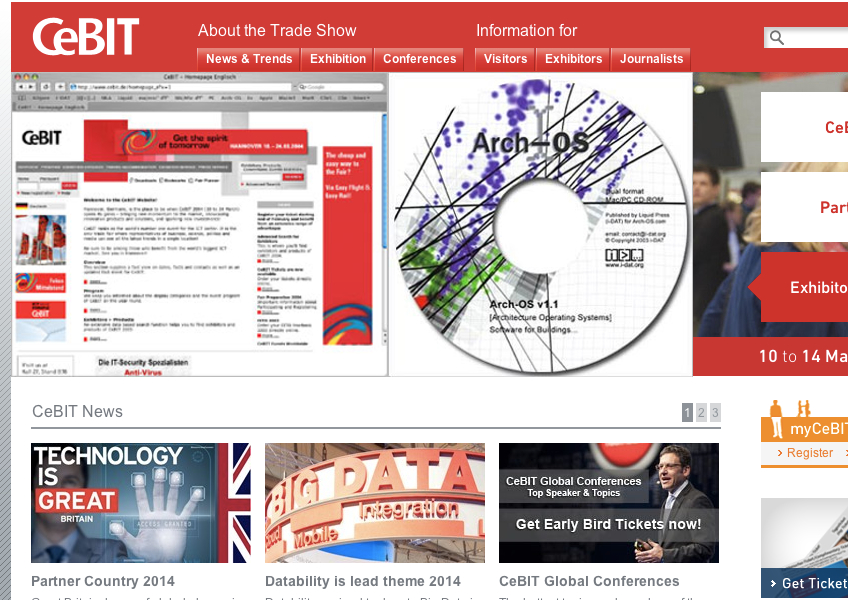
i-DAT exhibited Arch-OS technologies on the UK@ Stand, Hall 5, Stand F04 at CeBIT 2004 in Hanover, Germany on the 18 to 20 March 2004. Invited by the South West of England Regional Development Agency, Arch-OS will be representing research and innovation in the region.
“CeBIT ranks as the world’s number one event for the ICT sector. It is the only trade fair where representatives of business, science, politics and media can see all the latest trends in a single location!”
Visit the CeBit website: http://www.cebit.de/homepage_e
